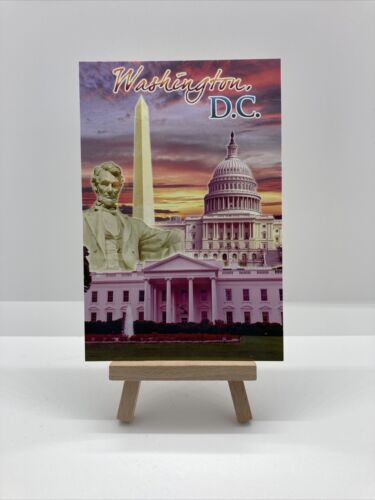-40%
Capitol Building, Washington DC
$ 0.39
- Description
- Size Guide
Description
Capitol Building, Washington DCphotographer - Marvin H. Wurtz
Travel Card Collection
published by Impact, copyright 1983
#: 2833 G-724
unsent
The United States Capitol, often called the Capitol Building, is the home of the United States Congress, and the seat of the legislative branch of the U.S. federal government. It sits atop Capitol Hill at the eastern end of the National Mall in Washington, D.C. Though not at the geographic center of the Federal District, the Capitol forms the origin point for the District's street-numbering system and the District's four quadrants.
The original building was completed in 1800 and was subsequently expanded, particularly with the addition of the massive dome, and expanded chambers for the bicameral legislature, the House of Representatives in the south wing and the Senate in the north wing. Like the principal buildings of the executive and judicial branches, the Capitol is built in a distinctive neoclassical style and has a white exterior. Both its east and west elevations are formally referred to as fronts, though only the east front was intended for the reception of visitors and dignitaries.
Prior to establishing the nation's capital in Washington, D.C., the United States Congress and its predecessors had met in Philadelphia (Independence Hall and Congress Hall), New York City (Federal Hall), and a number of other locations (York, Pennsylvania; Lancaster, Pennsylvania; Maryland State House in Annapolis, Maryland; and Nassau Hall in Princeton, New Jersey). In September 1774, the First Continental Congress brought together delegates from the colonies in Philadelphia, followed by the Second Continental Congress, which met from May 1775 to March 1781.
After adopting the Articles of Confederation in York, Pennsylvania, the Congress of the Confederation was formed and convened in Philadelphia from March 1781 until June 1783, when a mob of angry soldiers converged upon Independence Hall, demanding payment for their service during the American Revolutionary War. Congress requested that John Dickinson, the Governor of Pennsylvania, call up the militia to defend Congress from attacks by the protesters. In what became known as the Pennsylvania Mutiny of 1783, Dickinson sympathized with the protesters and refused to remove them from Philadelphia. As a result, Congress was forced to flee to Princeton, New Jersey, on June 21, 1783, and met in Annapolis, Maryland, and Trenton, New Jersey, before ending up in New York City.
The United States Congress was established upon ratification of the United States Constitution and formally began on March 4, 1789. New York City remained home to Congress until July 1790, when the Residence Act was passed to pave the way for a permanent capital. The decision to locate the capital was contentious, but Alexander Hamilton helped broker a compromise in which the federal government would take on war debt incurred during the American Revolutionary War, in exchange for support from northern states for locating the capital along the Potomac River. As part of the legislation, Philadelphia was chosen as a temporary capital for ten years (until December 1800), until the nation's capital in Washington, D.C., would be ready.
Pierre (Peter) Charles L'Enfant was given the task of creating the city plan for the new capital city. L'Enfant chose Jenkin's Hill as the site for the "Congress House", with a "grand avenue" (now Pennsylvania Avenue, NW) connecting it with the President's House, and a public space containing a broader "grand avenue" (now the National Mall) stretching westward to the Potomac River (see: L'Enfant Plan).
In reviewing L'Enfant's plan, Thomas Jefferson insisted the legislative building be called the "Capitol" rather than "Congress House". The word "Capitol" comes from Latin and is associated with the Temple of Jupiter Optimus Maximus on Capitoline Hill, one of the seven hills of Rome. The connection between the two is not, however, crystal clear. In addition to coming up with a city plan, L'Enfant had been tasked with designing the Capitol and President's House; however, he was dismissed in February 1792 over disagreements with President George Washington and the commissioners, and there were no plans at that point for the Capitol.
Shipping is {{detail_product_description}}.10 for each additional postcard purchase. NOTE: Highest shipping charge applies first then {{detail_product_description}}.10 for each additional postcard.










